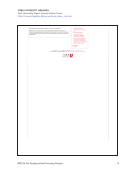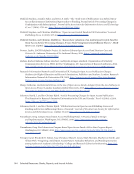2 Survey Results: Executive Summary
Introduction
Libraries and institutions that fund article processing charges (APCs) subsidize authors who publish
scholarly articles in open access (OA) journals that require per-article payment.1 Funding APCs removes
barriers to open publishing practices and promotes the value of OA to scholarship, research, and creative
output. APC funds align the investment with the core mission and values of libraries. Libraries that offer
such programs aspire to provide leadership in promoting the value of OA and proliferating OA practices
among academic authors.
When conceptualizing these and other programs, libraries often look to their peer and
aspirational institutions, including signatories of the Compact for Open-Access Publishing Equity (COPE)
Initiative http://www.oacompact.org/, members of the Scholarly Publishing and Academic Resources
Coalition (SPARC) http://sparcopen.org/open-access/, and members of the Association of Research
Libraries (ARL). The purpose of this survey was to explore the strategies that ARL member institutions
are using to address APCs—including how the funds are established and how they are handled (e.g.,
policies, applications, budgets, administration, outreach activities, etc.), sources of funding, and whether
and under what circumstances libraries are partnering with other units (or other libraries) to fund this
aspect of open access—and gather related policies and procedures. We asked libraries if their institution
had a fund that subsidized APCs, but our focus was on the library’s role in the process. We did not
attempt to find out about APC funding outside the library, such as grant funding or departmental support.
Overview
The survey was distributed to the 124 ARL member libraries in July 2016. Seventy-seven (62%)
responded by the August 1 deadline. Twenty-three of the responding libraries (30%) currently have a
fund and six are planning to start one in the near future (8%). Fourteen used to have a fund and 34 have
no plans for a fund. The 2012 SPEC survey on scholarly communication services asked a similar question
about whether the library administered an open access publishing fund.2 Forty-five libraries responded
to both surveys. A comparison of their responses in 2012 and 2016 shows movement in both directions.
In 2012, 14 of those 45 respondents answered yes. In 2016, seven of them have an APC fund and seven no
longer have a fund. Of the 31 respondents whose institutions did not offer a fund in 2012, seven now have
an APC fund and two are planning a fund, three used to have a fund, and 19 still have no plans for one.
The addition of nine new respondents who have an APC fund shows a slight increase in
the number of libraries that support OA publishing. And while SPARC’s surveys of North American
institutions also show an increase in the number of funds from nine in 2009 to 51 in 2014,3 it is
Executive Summary
Introduction
Libraries and institutions that fund article processing charges (APCs) subsidize authors who publish
scholarly articles in open access (OA) journals that require per-article payment.1 Funding APCs removes
barriers to open publishing practices and promotes the value of OA to scholarship, research, and creative
output. APC funds align the investment with the core mission and values of libraries. Libraries that offer
such programs aspire to provide leadership in promoting the value of OA and proliferating OA practices
among academic authors.
When conceptualizing these and other programs, libraries often look to their peer and
aspirational institutions, including signatories of the Compact for Open-Access Publishing Equity (COPE)
Initiative http://www.oacompact.org/, members of the Scholarly Publishing and Academic Resources
Coalition (SPARC) http://sparcopen.org/open-access/, and members of the Association of Research
Libraries (ARL). The purpose of this survey was to explore the strategies that ARL member institutions
are using to address APCs—including how the funds are established and how they are handled (e.g.,
policies, applications, budgets, administration, outreach activities, etc.), sources of funding, and whether
and under what circumstances libraries are partnering with other units (or other libraries) to fund this
aspect of open access—and gather related policies and procedures. We asked libraries if their institution
had a fund that subsidized APCs, but our focus was on the library’s role in the process. We did not
attempt to find out about APC funding outside the library, such as grant funding or departmental support.
Overview
The survey was distributed to the 124 ARL member libraries in July 2016. Seventy-seven (62%)
responded by the August 1 deadline. Twenty-three of the responding libraries (30%) currently have a
fund and six are planning to start one in the near future (8%). Fourteen used to have a fund and 34 have
no plans for a fund. The 2012 SPEC survey on scholarly communication services asked a similar question
about whether the library administered an open access publishing fund.2 Forty-five libraries responded
to both surveys. A comparison of their responses in 2012 and 2016 shows movement in both directions.
In 2012, 14 of those 45 respondents answered yes. In 2016, seven of them have an APC fund and seven no
longer have a fund. Of the 31 respondents whose institutions did not offer a fund in 2012, seven now have
an APC fund and two are planning a fund, three used to have a fund, and 19 still have no plans for one.
The addition of nine new respondents who have an APC fund shows a slight increase in
the number of libraries that support OA publishing. And while SPARC’s surveys of North American
institutions also show an increase in the number of funds from nine in 2009 to 51 in 2014,3 it is
Executive Summary
























































































































































